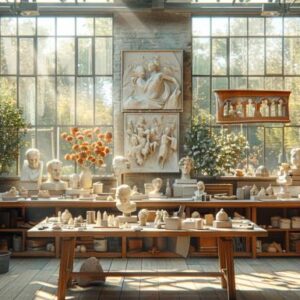Have you ever imagined transforming a piece of clay into a work of art with your own hands? In the comfort of your home, the ceramics journey can be a path of discoveries and unique expressions. In this guide for beginners, we reveal a universe where creativity takes shape between your fingers. Dive with us into the first steps to sculpting ceramics, learn about the essential tools and learn how to give life and finish to your pieces. Discover how to fashion unique pieces at home and feel the magic of creating something truly yours.
How can I start making pottery at home step by step?
Introduction to ceramics at home begins with preparing a suitable space for the practice: choose a clean, organized place with good lighting and ventilation. Basic modeling techniques for beginners include kneading the clay to eliminate air bubbles, shaping using pinching techniques, making rolls, building slabs and, if interested, modeling on a potter's wheel.
What are the first steps to molding pottery at home? Getting started involves establishing a workplace and understanding the basics of clay forming. Learn how to prepare clay properly, eliminating air pockets through the kneading process, to prevent explosions during kiln firing.
How can I prepare a suitable space for practicing pottery? Your space should be tidy, with easy-to-clean surfaces, and equipped with essential tools such as clay, a rolling pin, sculpting tools, and optionally a potter's wheel and oven.
What are the basic ceramic modeling techniques for beginners? The initial techniques involve basic clay handling: pinching to form small objects, using clay rollers to build shapes, assembling clay slabs into larger structures, and modeling on the wheel, which requires skill and practice.
Novice potters can explore the delights of craftsmanship and discover more about techniques and tools at Home Stories. By dedicating yourself to this craft, you will be embarking on a journey of continuous learning and creative satisfaction.
What tools and materials are essential for getting started with handmade pottery?
How do I choose the right clay for my pottery projects? The choice of clay is fundamental and must be aligned with the result you want. For beginners, earthenware clay is friendly and burns at lower temperatures. If you are looking for durability for objects such as crockery, stoneware clay is the option, as it is waterproof. Porcelain, despite being strong and beautiful, requires more skill to work.
What basic tools are needed to start pottery at home? You'll need a few basic tools to get started: clay, a rolling pin (like a kitchen rolling pin), a pottery kiln, sculpting tools, finishing glazes, and, for those who want to work on the lathe, the potter's wheel. Furthermore, a clean and organized space, with good lighting and ventilation, is essential.
Is there a list of essential materials for those just starting out? Yes, in addition to the tools and materials already mentioned, it is crucial to knead the clay well to eliminate air pockets and avoid explosions during firing in the kiln. The diversity of modeling techniques, care in the drying process, the application of glaze and the performance of two types of firing – biscuit and glaze – are important steps in the process. Safety precautions are also necessary, such as using appropriate equipment and handling materials correctly.
For a more detailed list of materials and tools and additional information about handmade pottery, visit Domestic.
How do I glaze and finish my ceramic pieces?
To apply glaze to ceramic pieces, follow these steps: clean the piece well, apply the glaze evenly with a brush or dip, and carefully remove excess glaze. Then, place the piece in the oven for the glaze to burn, following the appropriate temperature and time.
To obtain the best finish on handmade ceramics, it is essential to ensure that the glaze is applied evenly and without bubbles. Choosing the correct glaze, considering the properties of the clay and the firing temperature, is also a crucial factor.
There are several techniques for customizing the finish of ceramics, such as adding textures before applying the glaze, using multiple layers of different glazes or even alternative firing methods, such as raku, which provide diverse and unique aesthetic results.
A handmade ceramics it is a field rich in possibilities, allowing both novices and experienced artists to explore their creativity. Through experimentation with different enameling and finishing techniques, each piece can become a personal artistic expression, blending technical skill, chemical knowledge of materials and the artist's personal style.
What safety precautions should I take when working with ceramics?
Protecting yourself during the process of working with ceramics includes the use of personal safety equipment, such as masks to prevent dust inhalation, protective glasses, and gloves when handling chemicals or hot parts. To keep your equipment always in good condition, it is important to follow the manufacturer's instructions for proper maintenance, which includes periodic cleaning, checking components and replacing worn parts. Furthermore, organizing and sanitizing the space after each use prevents the accumulation of ceramic dust and other residues that could be harmful to your health or compromise the creation of your pieces.
A cleaning and maintenance of ceramic equipment They are vital to ensuring the longevity of tools and ensuring the safety of the working environment. By regularly checking for defects or signs of wear and cleaning properly after each work session, you avoid complications and ensure optimal performance of your tools. Apart from this, the space where you work must be kept free of residue, using vacuum cleaners with HEPA filters or moistening the area before the cleaning procedure, to avoid the suspension of particles in the air.
Safe practices, combined with a well-prepared environment and appropriate tools, are the foundations for exploring ceramics in your home in a safe and enjoyable way.
In this article, we explore the path to starting the art of ceramics at home, from choosing clay and fundamental tools, to the glazing techniques that will bring your creations to life. We also emphasize the necessary safety precautions to ensure that your journey is not only creative, but also safe and enjoyable. With this information, we hope you feel equipped and inspired to shape not just clay, but also a new chapter filled with learning and self-expression in your life. May your hands be the beginning of a legacy of unique pieces, full of history and personality.
FAQ: Handmade Pottery Step by Step
How can I start making pottery at home?
To start making pottery at home, choose a clean, organized space with good lighting and ventilation. Learn basic modeling techniques, such as kneading clay to eliminate air bubbles and shaping with pinches, rollers and plates. Finally, dedicate yourself to continuous practice to develop your skills.
What materials are essential for those who want to start making handmade ceramics?
Essential materials for getting started in handmade pottery include clay, preferably earthenware for beginners, a rolling pin, sculpting tools, a pottery kiln and, optionally, a potter's wheel and glaze for finishing. In addition to tools, you need an adequate space for practice.
What is the correct process for glazing and finishing ceramic pieces?
To glaze and finish ceramic pieces, you must clean the piece properly, apply the glaze evenly and remove excess. Then, fire the glaze in the oven, respecting the recommended temperature and time. Experiment with different techniques and glazes to customize the finish of your pieces.
What safety precautions should I take when working with ceramics at home?
When working with ceramics at home, use safety equipment such as masks, safety glasses and gloves. Keep equipment and tools very clean and maintained according to the manufacturer's instructions. Additionally, clean and sanitize the workspace after use to prevent health risks.







